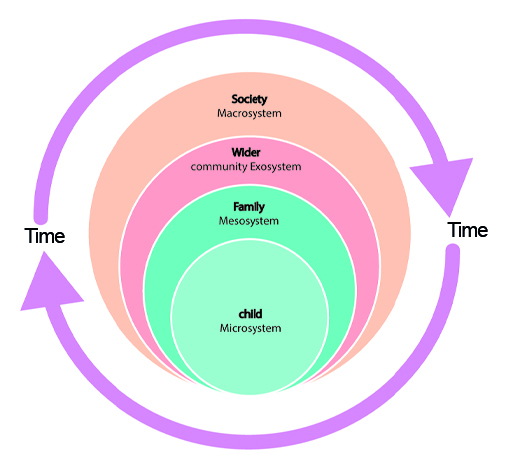3 Resources that promote a child’s mental health and wellbeing
There are many factors in children’s lives that can help to contribute to their wellbeing which in turn can help them to have good mental health.
To illustrate this point, you will now look at the work of Urie Bronfenbrenner, an American sociologist who researched the interaction between the individual and their environment. Bronfenbrenner developed a theory of how each child’s development is influenced by their relationship with the groups and communities around them as well as with wider society. His theory was named the bioecological model (1979) and he illustrated the theory in a diagram which put the child in the centre of a nest of circles. Moving out from the child, each circle represented a system around the child. This theory is useful to illustrate the influences on children’s mental health.
In Figure 8, the systems around the child have been separated out to illustrate how we can think about the factors within each system.
The inner circle represents the resources within the individual child (the microsystem), then moving outwards, the resources within their family (mesosystem) and local community (exosystem) such as pre-school/school or places of worship, and, finally, the outer circle (macrosystem) which represents the resources within wider society that help children to develop good mental health. Around each of the systems is the passage of time, suggesting that situations and circumstances evolve over time and will change as a matter of course in response to external events. The child themselves will also continue to grow and move across the systems as they move further into the world and away from their family networks.
Earlier in this session you saw how, at different points in history, wider social issues such as war have had a significant impact on how families function and the extent to which children thrive in more challenging environments.
You will find it helpful to return to these different systems as you examine how various practices and policies might affect children’s wellbeing, and the ways that the different ‘layered systems’ might work together to promote more positive mental health in young children and their families, as well as the communities in which they live.
Activity 5 Identifying resources that can make a positive contribution to children’s mental health
Make a list of the resources within each of the circles that you think can make a positive contribution to children’s mental health.
Discussion
The following are some suggestions of the resources that you may have listed for each of the systems. Don’t worry if you included other resources or worded things in a different way. The main point is that each of the different systems has an influence on the others.
- Within the child (the microsystem): determination, intelligence, resilience, perseverance, a sense of good wellbeing.
- Within the family (the mesosystem): an emotionally responsive home with settled routines, good relationships, and all physical needs met. In Session 3, you will look at the important process of attachment. You will understand how the building of secure attachments in the early years can help to develop positive views of self and effective future relationships with others.
- Within the community (the exosystem): good quality pre-schools and schools, health services, a safe environment with access to outdoor areas for play. You will have the opportunity to reflect on the ingredients that make up good quality care and education in Session 5. In the same session, you will focus on the significance of play for the promotion of children’s mental health and wellbeing as part of the early years curriculum.
- Within society (the macrosystem): laws that protect children and help prevent harm that can make the occurrence of adverse childhood experiences more likely. Positive societal attitudes that take account of children’s rights will be a resource that you will explore more fully in Session 4.
Safeguarding laws in England are an example of the national approach that states that it is everybody’s responsibility to protect the welfare of children, and therefore these are resources within society. You will be introduced to these laws in Session 5.
It is worth bearing in mind that even if children have many of the resources available to them, some children will still develop a mental health condition. And the opposite is also the case: children who have experienced a great deal of adversity and are missing many of the positive factors in the systems around them do not necessarily develop poor mental health.

